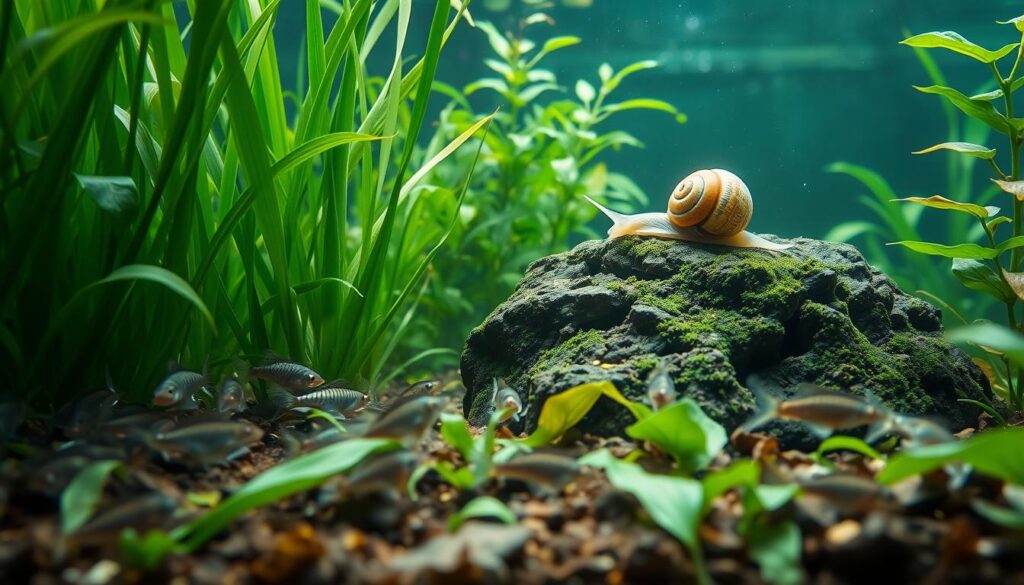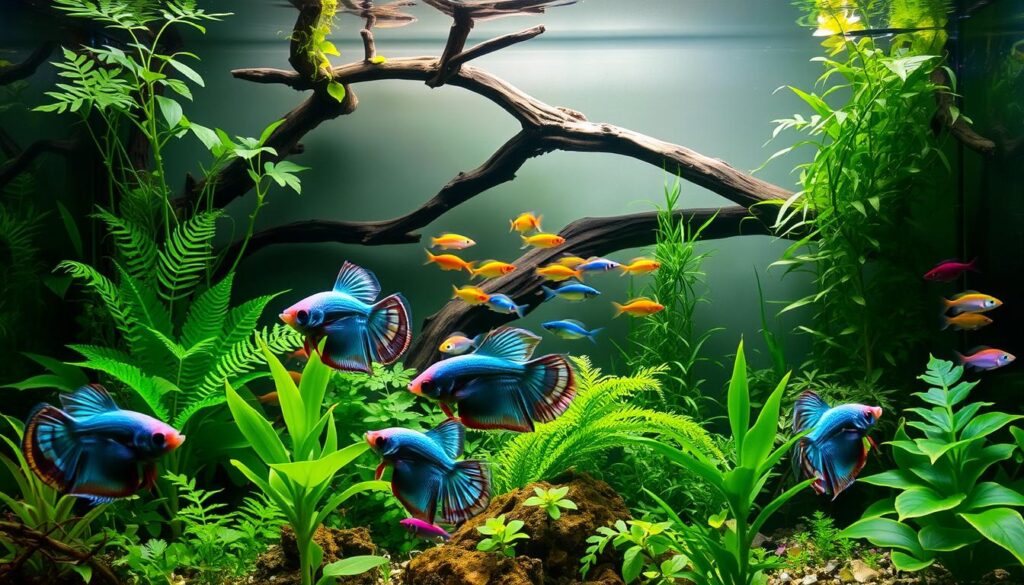Setting up a betta sorority tank can be a beautiful and rewarding experience—but it requires careful planning, especially when choosing the right companions. If you’re searching for the best betta sorority tank mates, you’re in the right place. Female bettas can be territorial, and the wrong tank mates might lead to stress or aggression. In this guide, we’ll explore which species make ideal betta sorority tank mates, how to introduce them properly, and tips to maintain a peaceful aquatic environment.
Start with a 10-gallon tank for your fish. A long, horizontal tank is best. It gives your female betta fish plenty of space to swim and claim their territory. With the right setup and careful selection of tank mates, your aquarium will be a colorful and lively display!
Key Takeaways
- Choose a minimum 10-gallon tank for your betta sorority.
- Select compatible tank mates to ensure harmony.
- A long, horizontal tank provides ample swimming space.
- Careful planning is crucial for a thriving betta sorority.
- Research is key to creating a vibrant community.
Understanding Betta Sororities
Setting up a betta sorority tank is an exciting journey into the world of female betta fish communities! A betta sorority is a group of female betta fish living together in harmony.
What Is a Betta Sorority?
A betta sorority is a group of female betta fish living together in a peaceful aquarium. Unlike male bettas, female bettas can live together. But, their aggressive tendencies and territorial behavior need careful attention.
Female Betta Behavior and Temperament
Female bettas are known to be aggressive and territorial. This makes it important to watch their behavior and provide hiding spots. Younger females tend to get along better in a sorority than older ones.
Ideal Number of Females for a Sorority
The best number of females in a sorority is usually 5 to 7. This number helps create a diverse community while keeping aggression low. and betta sorority tank companions are key to a peaceful environment.
Read Also Betta Fish Stress Stripes: What They Mean and How to Treat Them
Common Misconceptions About Betta Communities
Many think betta fish must live alone. But, with the right planning and care, a thriving betta sorority is possible. It offers a unique and captivating aquarium experience.
Tank Requirements for a Successful Betta Sorority
To keep your betta sorority happy and healthy, you’ll need to get the tank just right! A well-set-up tank is not just a pretty face; it’s the foundation of a thriving community. So, what makes a tank suitable for a betta sorority?
Minimum Tank Size and Shape Considerations
A minimum tank size of 10 gallons is recommended for a betta sorority. But why is size so important? Well, a larger tank provides a more stable environment and gives your betta ladies the space they need to establish their own territories. A long, horizontal tank is preferable as it allows for better swimming and territorial establishment.
Read Also Female Betta Sorority Tank: Creating a Harmonious Community
Optimal Water Parameters and Temperature
Betta fish are tropical, so they thrive in warm water. The ideal temperature range is between 72-81 degrees Fahrenheit. Water parameters are also crucial; maintaining a pH between 6.5 and 8, with regular water changes, will keep your betta sorority healthy.
Filtration and Water Flow Requirements
A good filtration system is essential, but it’s equally important to ensure that the water flow isn’t too strong. Betta fish aren’t the strongest swimmers, so a gentle current is best. Consider using a sponge filter or adjusting your filter’s output to minimize flow.
Read Also What Does Betta Fish Poop Look Like? (Normal vs. Problem Signs)
Essential Decorations and Hiding Places
Decorations aren’t just for show; they provide crucial hiding places and help establish territories. Use a mix of plants, rocks, and driftwood to create a natural environment. This not only reduces stress but also makes your tank look amazing!
| Tank Requirement | Recommendation |
|---|---|
| Minimum Tank Size | 10 gallons |
| Ideal Temperature Range | 72-81°F |
| Water Flow | Gentle current |
| Decorations | Plants, rocks, driftwood |
Try the CousDUoBe 2-Pack Betta Fish Leaf Pad – it simulates their natural habitat, creating a cozy, organic, and stress-free resting spot. Perfect for any Betta aquarium!
👉 Click here to buy the best one now! The Ideal Betta Sorority Tank Mates
Finding the right betta sorority fish tank partners is key! The perfect tank mates can make your betta sorority thrive. It’s all about creating a harmonious community.
Characteristics of Compatible Fish Species
So, what makes a fish a good match for your betta sorority? Look for species that are:
- Peaceful and non-aggressive
- Not fin-nippers or scale-biters
- Able to thrive in similar water conditions
- Not competing for the same food or territory
Great options include mystery snails, ghost shrimp, cory catfish, and harlequin rasbora. These fish are not only compatible but also add variety and interest to your tank.
Fish to Absolutely Avoid
There are some fish you should absolutely avoid for your betta sorority. These include:
- Aggressive or fin-nipping fish like tiger barbs or fin-nipping tetras
- Large or predatory fish that may see your betta as prey
- Fish that require drastically different water conditions
By avoiding these fish, you’ll be well on your way to creating a peaceful and thriving community!
Stocking Ratios and Bio load Considerations
When introducing new tank mates, consider the stocking ratio and bio load. Start with a small number of tank mates and gradually add more. Monitor the tank’s bio load and your betta’s behavior.
Temperament Matching for Peaceful Coexistence
Temperament matching is crucial for a harmonious betta sorority. Choose tank mates with similar temperaments to your betta. This way, you can create a peaceful and stress-free environment. For example, if your betta is active or feisty, choose tank mates that can keep up!
Peaceful Bottom Dwellers for Betta Sororities
A betta sorority tank can be lively and interesting with the right fish. These fish add variety and help keep the tank clean. They make sure the bottom is free of debris.
Read Also Why Your Betta Fish Fin Rot Cure Isn’t Working (And What to Do Instead)
Corydoras Catfish Varieties
Corydoras catfish are great for community tanks, including betta sororities. They are peaceful and good at cleaning. You can choose from many varieties like Corydoras albino, Corydoras sterbai, and Corydoras panda. They are easy to care for and need a clean tank with hiding spots.
Kuhli Loaches and Other Loach Options
Kuhli loaches are perfect for betta sorority tanks. They are quiet, active at night, and control snails. Other loaches like Yoyo loaches or Clown loaches are also good, but they need bigger tanks and special care.

Otocinclus and Other Algae Eaters
Otocinclus catfish are small and peaceful. They love to eat algae and keep your tank clean. Other algae eaters like Amano shrimp or Nerite snails are also good, even though they are invertebrates.
Peaceful Plecos for Larger Setups
In bigger tanks (55 gallons or more), peaceful plecos can be a good choice. Species like Common pleco or Bristlenose pleco do well in large tanks. But, make sure to research their needs, as some can grow big.
| Fish Type | Tank Size Requirement | Special Care Needs |
|---|---|---|
| Corydoras Catfish | 20 gallons or more | Plenty of hiding places, soft substrate |
| Kuhli Loaches | 20 gallons or more | Dim lighting, hiding places |
| Otocinclus | 20 gallons or more | Abundant algae or algae wafers |
| Peaceful Plecos | 55 gallons or more | Large hiding places, varied diet |
When adding new fish to your betta sorority, do it slowly. Watch them closely to make sure they get along and don’t stress out.
Mid-Water Swimming Companions
Adding mid-water swimmers to your betta sorority can make it more lively and visually appealing! It’s important to pick tank mates that are friendly and won’t bother your betta or other fish.
Rasbora Species
Rasboras like Harlequin, Chili, and Lambchop are great for betta sorority tanks. They’re calm, active, and add lots of movement in the middle water layer.
Compatible Tetra Varieties
Ember, Neon, and Black Neon tetras are also good choices. These schooling fish do best in groups of 6-10 or more. This helps reduce stress and encourages natural behavior.
Small Danios and Minnows
Small danios and minnows can also do well in a betta sorority tank. They’re full of energy and can make the tank lively. Just make sure they’re not too big or fin-nippy.
Endler’s Livebearers and Guppies
Endler’s livebearers and guppies are colorful and peaceful. They’re small and can thrive in well-planted tanks with lots of hiding spots.
| Fish Species | Schooling Behavior | Compatibility |
|---|---|---|
| Rasbora | Yes, prefer schools of 6+ | High |
| Tetras | Yes, prefer schools of 6-10+ | High |
| Danios | Yes, active swimmers | Medium to High |
| Endler’s Livebearers | No, but enjoy company | High |
| Guppies | No, but enjoy company | High |
When adding these mid-water swimmers to your tank, do it slowly and watch closely. This helps avoid stress or aggression.
Invertebrate Options for Betta Sorority Tanks
Adding invertebrates to your betta sorority tank can be a big plus! Shrimp and snails bring variety and interest. They help make your tank a balanced ecosystem.
Freshwater Shrimp Varieties
Freshwater shrimp are a favorite for betta sorority tanks. Amano, Cherry, and Ghost shrimp are not just pretty. They also clean up algae and detritus. Amano shrimp are top at controlling algae, and Cherry shrimp add color.
Snail Species
Snails are great for betta sorority tanks too. Nerite snails fight algae, and Mystery snails clean up detritus. Ramshorn snails are good, but watch out for their fast breeding.
Protecting Invertebrates from Predation
To keep invertebrates safe, add lots of hiding spots and barriers. Plants, rocks, and driftwood do the trick. They make your invertebrates feel safe and reduce harassment from betta or other fish.
- Use plants like Java moss or Anubias to create hiding spots.
- Add rocks and boulders to create crevices.
- Incorporate driftwood for additional hiding places.
Benefits of Invertebrates in Community Tanks
Invertebrates are a big plus for community tanks. They control algae, clean up detritus, and add interest. Adding them to your betta sorority tank makes it more dynamic and fun for everyone.
Creating a Balanced Ecosystem
A thriving betta sorority tank needs more than just the right tank mates. It also needs a balanced ecosystem. This means considering live plants, setting up territories, feeding strategies, and regular water changes.
Live Plant Selection for Betta Communities
Live plants are key to a balanced ecosystem in a betta sorority tank. They add oxygen, soak up excess nutrients, and provide hiding spots for your fish. Good choices include Java Moss, Anubias, and Amazon Swords. These plants are not only beautiful but also easy to care for.
Establishing Defined Territories
Betta fish are territorial. So, it’s important to set up defined areas in the tank. Use plants, rocks, and decorations to divide the space. This reduces aggression and stress among your fish. For example, create a plant thicket in one corner or use a divider to separate areas.
Feeding Strategies for Multiple Species
Feeding multiple species in your tank can be tricky. Offer a varied diet that includes high-quality flakes, pellets, and live or frozen foods. For instance, feed your betta fish bloodworms or brine shrimp, while other fish enjoy community flakes.
Water Change Schedules for Community Tanks
Regular water changes are vital for a healthy environment. For a betta sorority tank, aim to change 25% of the water every week. This keeps water parameters stable and prevents toxin buildup. Use a gravel vacuum to remove debris and waste during water changes.
| Task | Frequency | Notes |
|---|---|---|
| Water Changes | 25% every week | Use a gravel vacuum to remove debris |
| Plant Trimming | As needed | Trim or prune plants to maintain shape and promote healthy growth |
| Feeding | 2-3 times a day | Vary the diet to ensure nutritional balance |
By following these tips, you can create a balanced ecosystem in your betta sorority tank. This will keep your fish happy and healthy. Remember, a thriving community tank is all about balance and harmony!
Introducing New Tank Mates Safely
Adding new fish to your betta sorority can be exciting. But, it needs careful planning to keep the peace. Introducing new fish right can make your tank more lively and diverse. Yet, it’s key to do it in a way that avoids stress and disease.
Quarantine Procedures and Duration
Quarantining new fish is a crucial step you can’t skip. It stops diseases from spreading to your community. The quarantine period is usually 2 to 4 weeks, based on the fish’s health and type.
Watch your new fish for illness signs like labored breathing or lethargy. A clean quarantine tank with good filtration and temperature is vital for their health.
| Fish Type | Recommended Quarantine Duration | Key Observations |
|---|---|---|
| Betta Fish | 2-3 weeks | Fin condition, activity level |
| Tetras and Danios | 2-4 weeks | Signs of parasites, schooling behavior |
| Corydoras Catfish | 2-3 weeks | Feeding behavior, visible injuries |
Proper Acclimation Methods
Acclimating new fish to your tank’s water is crucial to reduce stress. The floating bag method is a common technique. It involves floating the bag in the tank for 15-20 minutes to match the water temperature.
Then, slowly add tank water to the bag over 15-30 minutes. This gradual change helps the fish adjust to the tank’s water. Once they’re acclimated, you can release them into the tank.

Rearranging Decor During Introductions
When introducing new fish, rearranging the tank decor can help. It reduces aggression by creating a new environment for all fish.
Changing the layout can include moving plants or adding new decorations. It’s a simple way to reduce territorial behavior and help fish get along better.
Monitoring Behavior and Stress Signals
After introducing new fish, watch the tank closely. Look for signs of stress or aggression like fin nipping or chasing. Some aggression is normal, but constant behavior is a problem.
Also, observe feeding behavior. If some fish are not eating or are being bullied, you might need to separate them or change how you feed.
By following these steps and being patient, you can add new tank mates to your betta sorority successfully. This creates a thriving and peaceful community.
Troubleshooting Common Issues with Betta Sorority Communities
Even with the best care, problems can still happen in our betta sorority tanks. But, with the right knowledge, we can solve them quickly! Keeping a thriving community means paying close attention and being ready to fix issues fast.
Identifying and Addressing Aggression
Aggression is a big problem in betta sorority tanks. To reduce fights, make sure your tank is big with lots of hiding spots and barriers. If aggression keeps happening, try changing the tank’s layout or adding more plants.
For the best tank mates for betta sorority, pick calm fish that won’t start fights.
Disease Prevention in Community Tanks
Stopping disease is key in a community tank. Do regular water changes and check the water’s health. Quarantine new fish before adding them to the main tank to avoid diseases. A clean tank with good water quality keeps your fish healthy.
When to Remove or Separate Fish
If aggression doesn’t stop or a fish is always bullied, it might need to be removed or separated. Watch your fish closely and be ready to act if needed. Sometimes, moving an aggressive fish is best for everyone’s safety.
Reestablishing Harmony After Problems
After fixing a problem, let your tank calm down. You might need to adjust the tank’s setup or the number of fish to keep it peaceful. With patience and the right steps, you can keep a happy betta sorority community with the recommended tank mates for betta sorority.
Conclusion: betta sorority tank mates
Creating a thriving betta sorority community is rewarding. It needs careful planning and a willingness to learn. You’ve learned that picking the right tank mates is key for harmony.
We’ve talked about the importance of tank conditions. This includes the right tank size, water quality, and decorations. We’ve also looked at fish species that get along with your female betta.
To sum up, a successful community needs the right tank mates and good tank conditions. Being ready to solve problems is also important. With patience and effort, you can have a lively community that shows off your betta and their friends.
So, start building your betta sorority community today! With the right advice and creativity, you’ll soon have a peaceful and interesting aquarium. It will be filled with the perfect tank mates for your betta.

